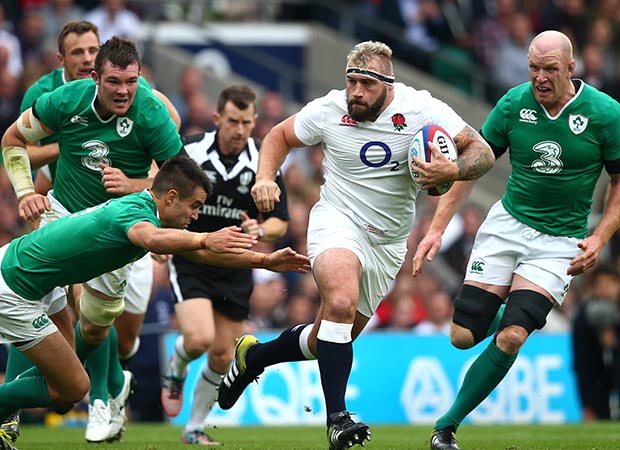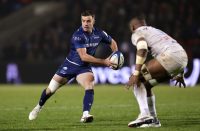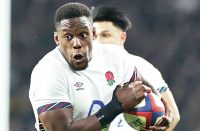 England go into the Six Nations in the grip of an injury drought that will test their well of playing talent to the limit. That handicap will demand that Eddie Jones and his team of coaches excel in terms of selection and tactical insight if they are to stretch their unbeaten ledger to produce a second successive Grand Slam, as well as set a world record of 19 successive Test wins.
England go into the Six Nations in the grip of an injury drought that will test their well of playing talent to the limit. That handicap will demand that Eddie Jones and his team of coaches excel in terms of selection and tactical insight if they are to stretch their unbeaten ledger to produce a second successive Grand Slam, as well as set a world record of 19 successive Test wins.
The quest starts on Saturday, with an England pack stripped of four first choice forwards – who were fundamental to last season’s success – absent for the opener against France.
How successfully England repair the damage left by the unavailability of Mako and Billy Vunipola, James Haskell and Chris Robshaw, will be the key factor in whether they start the campaign with their 14th consecutive win under Jones. There will be justifiable apprehension among Red Rose supporters. What they will dread most is hearing the dry rattle when the life-giving reservoir of international talent runs out – and of all teams for it to happen against, they will not want it to be the French.
There is a lot of dewy-eyed, sentimental claptrap talked about French rugby on this side of the Channel, based mainly on the 1970s. In that era, as well as having a juggernaut pack, they had a handful of inspirational loose forwards – such as Jean-Pierre Rives, Jean-Claude Skrela and Jean-Pierre Bastiat – with the handling skills and athleticism to play like auxiliary backs.
After that, including in their Six Nations salad days in the 1980s and early 1990s, the flashes of brilliance from Serge Blanco and Philippe Sella were regularly overshadowed by their shift towards grinding ‘method’ rugby. Whenever France broke free of it – as they did by counter-attacking brilliantly against New Zealand in the 1999 World Cup semi-final – the fanfare for French flair was kept alive.
The reality is that in the pro era flair has been a rapidly diminishing commodity in the ranks of ‘Les Bleus’. Despite some commentators trotting out superlatives whenever France scored tries – which if they had been touched-down by anyone else would have been called ‘workmanlike’ – the cover-up was doomed.
If Rives and co lit up the stage 40 years ago, the French idea of a splash of colour has been mainly grey since the game went professional, with the payback in non- entertainment over the last 18 years nothing short of brutal. For most of that time France have been the most boring, uninspired side in the Six Nations.
The elan they had in the 1970s migrated elsewhere, with New Zealand forging a new attacking frontier – and England, under Eddie Jones, and Clive Woodward before him, also playing the game with far more flourish and flair than France.
That shift was evident again when England scored three tries to nil in Paris to clinch last season’s Slam. As for the ancient French foe, there were signs against New Zealand and Australia this autumn that, alongside the battering-ram approach they have been in thrall to, there is a welcome shift under coach Guy Noves towards movement as well as muscle.
It is muscle against movement that is the tipping point in this latest England encounter with France. The concern among Gallic pundits is that while Noves’ side have the size and weight to cause England problems at the set-piece, squeezing them at the scrum and knocking them back with steaming line-out drives, they lack the athleticism and high octane conditioning to live with Dylan Hartley’s crew if it is fast and loose for 80-plus minutes.
The French worry is that second rows Sebastien Va’ahamina and Yoann Maestri, and the trio of No.8s in their back row (Loann Goujon, Kevin Gourdon, Louis Picamoles) will not have the engines to match the workrate of George Kruis, Courtney Lawes and Maro Itoje, or to a lesser extent, Tom Wood and Nathan Hughes.
Hughes has a big task filling Billy Vunipola’s shoes, and it is noticeable that he has been playing tighter at No.8 for Wasps and throwing fewer of the one-handed miracle passes. He has the size and mobility to rise to the challenge – and England need him to.
However, if Les Blues are going forward at scrum and line-out, and England are rocked onto their heels, it will lessen the aerobic load on the French heavyweights – and it is here that set-piece coach Steve Borthwick and his England pack are most likely to either win the day, or lose it.
 There are a number of good reasons for the French to believe that England are vulnerable at the scrum. The first is that if Joe Marler, above, recovers from his hairline leg fracture to start ahead of Ellis Genge and Matt Mullan at loose-head – as the sounds emanating from the England camp suggest – he will do so having not played for a month. If the Harlequins prop had been in outstanding form for his club before he was injured there might be greater cause for optimism, but Marler was not in his pomp.
There are a number of good reasons for the French to believe that England are vulnerable at the scrum. The first is that if Joe Marler, above, recovers from his hairline leg fracture to start ahead of Ellis Genge and Matt Mullan at loose-head – as the sounds emanating from the England camp suggest – he will do so having not played for a month. If the Harlequins prop had been in outstanding form for his club before he was injured there might be greater cause for optimism, but Marler was not in his pomp.
It was unfortunate, also, that by the time Genge came off the bench last weekend to square up against Glasgow’s impressive young tight-head, Zander Fagerson, Leicester had already been blown away. Worse still, England’s first choice tight-head, Dan Cole, was part of the routed Tigers pack. With Mullan’s stock also slipping in a Wasps scrum which has struggled in recent weeks without the strength of injured tight-head Jake Cooper-Woolley, there does not appear to be a port in the storm.
Certainly, the fridge-like French tight-head, Uini Atonio, will never have a better chance to make his name – irrespective of whether he is grappling with Marler, Genge or Mullan. With Hartley also desperately short of match-practice, and Cole’s credentials about to be challenged by the solid Toulouse loose-head, Cyril Baille, Borthwick will deserve rich plaudits should England stand and deliver at the scrum, and also stall the French driving maul.
While that will have to wait until the dust has settled at Twickenham, there are crucial issues that Jones must address over the course of this campaign if he is to keep his 2019 World Cup plan intact.
The England head coach has said that this season is his second year of examining options, before going to the second stage with a 20 month preparation period, and a final four-month gallop in a bid to become world champions. That means that he and Borthwick will have to assess the readiness of Genge and Kyle Sinckler, the equally raw understudy to Cole, to be starting props by the time the 2018 season arrives. When it comes to tight-head strongmen what we do know is that Ireland‘s Tadhg Furlong and Scotland‘s Fagerson have given their teams an authority that the English scrum lacks.
There is also the question of whether Hartley – who looked well-honed at the Six Nations launch in London – can continue to keep Jamie George out of the starting line-up at hooker on captaincy credentials rather than playing form. So far, Hartley’s leadership has been seen as crucial by Jones, but George could strengthen his own hand if he became captain of Saracens.
It seems, however, that George has a rival in Owen Farrell, with Jones stating last week that despite English rugby’s overall failure to produce self-reliant leaders, he saw the Saracens fly-half as someone who could step up at international level. Irrespective of who the front-runners are, England will need to find other leaders over the next year as insurance against Hartley not making the 2019 World Cup.
Another thorny issue to be settled over the course of this tournament is whether, with Farrell already being talked of as a Lions test fly-half, George Ford makes the tour to New Zealand. The outcome could obviously be decisive in which of the two Jones decides to back as his No.10 heading into the World Cup, and with the stakes getting higher both of them will have to put down a marker in this Six Nations.
With Ford already seen as being behind in the pecking order, now is the time for him to rise to the challenge and showcase his all-court skills, and especially to use his footwork and acceleration to break the defensive line more often. His pressure goal-kicking has also dipped well below test standard, and requires urgent attention.
 Another big fix in this Six Nations is developing a world-class back row unit despite the loss of Billy Vunipola’s match-winning power.
Another big fix in this Six Nations is developing a world-class back row unit despite the loss of Billy Vunipola’s match-winning power.
One question likely to be answered sooner rather than later is whether Itoje, above, is as effective at blindside flanker as he is at lock, and given his adaptability and athletic prowess – as well as the fact that he has done well there for Saracens – the signs are encouraging. It is a pity that the same cannot be said at openside, where, in the continued absence of Haskell due to foot trouble, Tom Wood has re-staked his claim. Wood is a blindside, but neither Teimana Harrison nor Jack Clifford have yet made the breakthrough necessary to stake a claim to the 7 shirt, leaving the English back row short of the foraging and linking dynamism that world champion sides boast.
The head coach has also made no bones about his search for a different attacking dimension at full-back from the one offered by Mike Brown. At the moment the Quins No.15 is head and shoulders above his rivals when it comes to aerial combat. He is a safe pair of hands under the high ball, and as brave as they come, and at the moment that makes him indispensable.
Where Brown is not so good is in his awareness of giving attacking opportunities to others when he comes into the line, and that is why Jones is eyeing the possibilities of using Elliot Daly or Anthony Watson at full-back. Daly’s ability to read defences and unpick them, and Watson’s opportunism, allied to the blistering pace that both offer, make them tantalising prospects at 15.
However, if they want to unseat Brown they will have to become starship troopers under the high ball, because neither match him in the air now.
How successful Jones is in resolving these issues will dictate not only England’s chances of winning a successive Grand Slam, but whether their 2019 world champion ambitions remain on course.























